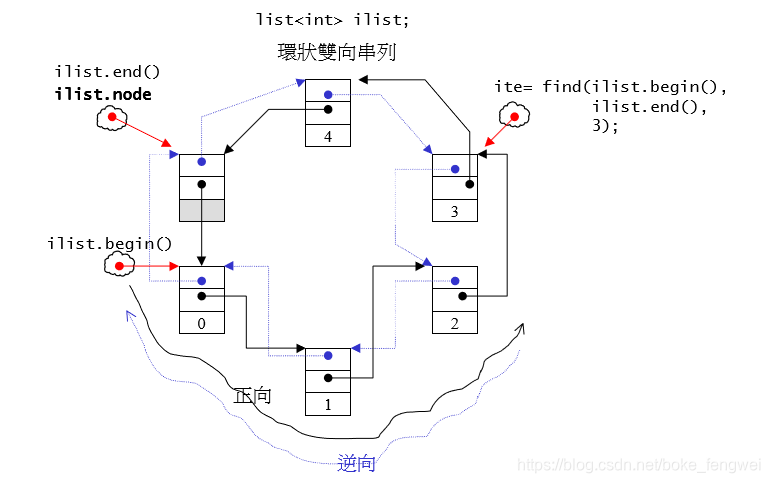list的介绍和使用
list的模拟实现
list和vector的对比
- list的介绍和使用
list的介绍
- list是可以在常数范围内在任意位置进行插入和删除的序列式容器,并且该容器可以前后双向迭代。
- list的底层是双向链表结构,双向链表中每个元素存储在互不相关的独立节点中,在节点中通过指针指向 其前一个元素和后一个元素。
- list与forward_list非常相似:最主要的不同在于forward_list是单链表,只能朝前迭代,已让其更简单高 效。
- 与其他的序列式容器相比(array,vector,deque),list通常在任意位置进行插入、移除元素的执行效率 更好。
- 与其他序列式容器相比,list和forward_list最大的缺陷是不支持任意位置的随机访问,比如:要访问list 的第6个元素,必须从已知的位置(比如头部或者尾部)迭代到该位置,在这段位置上迭代需要线性的时间 开销;list还需要一些额外的空间,以保存每个节点的相关联信息(对于存储类型较小元素的大list来说这 可能是一个重要的因素)

list的使用
list的接口比较多,下面列举常用的接口
assign() 给list赋值
back() 返回最后一个元素
begin() 返回指向第一个元素的迭代器
clear() 删除所有元素
empty() 如果list是空的则返回true
end() 返回末尾的迭代器
erase() 删除一个元素
front() 返回第一个元素
get_allocator() 返回list的配置器
insert() 插入一个元素到list中
max_size() 返回list能容纳的最大元素数量
merge() 合并两个list
pop_back() 删除最后一个元素
pop_front() 删除第一个元素
push_back() 在list的末尾添加一个元素
push_front() 在list的头部添加一个元素
rbegin() 返回指向第一个元素的逆向迭代器
remove() 从list删除元素
remove_if() 按指定条件删除元素
rend() 指向list末尾的逆向迭代器
resize() 改变list的大小
reverse() 把list的元素倒转
size() 返回list中的元素个数
sort() 给list排序
splice() 合并两个list
swap() 交换两个list
unique() 删除list中重复的元素
#include <iostream>
#include <string>
#include <list>
using namespace std;
struct Student
{
int id;
string name;
int score;
};
#define func_log(s, s2) do {cout << "[" << s << "] " << s2 << endl;} while (0);
list<Student> Students;
void add(Student &obj)
{
func_log(__func__, "");
Students.push_back(obj);
}
void remove(int id)
{
func_log(__func__, "");
list<Student>::iterator it = Students.begin();
for (it; it != Students.end(); it++)
{
if (id == it->id)
{
cout << "remove: " << id << endl;
Students.erase(it);
break;
}
}
func_log(__func__, "end");
}
void modify(Student &obj)
{
func_log(__func__, "");
list<Student>::iterator it = Students.begin();
for (it; it != Students.end(); it++)
{
if (obj.id == it->id)
{
cout << "modify: [id]: " << obj.id << endl;
cout << "modify: [name]: " << obj.name << endl;
cout << "modify: [score]: " << obj.score << endl;
*it = obj;
break;
}
}
func_log(__func__, "end");
}
int search(int id, Student &obj)
{
func_log(__func__, "begin");
int result = false;
list<Student>::iterator it = Students.begin();
for (it; it != Students.end(); it++)
{
if (id == it->id)
{
obj = *it;
cout << "Found: [id]: " << obj.id << endl;
cout << "Found: [name]: " << obj.name << endl;
cout << "Found: [score]: " << obj.score << endl;
result = true;
break;
}
}
func_log(__func__, "end");
return result;
}
void show()
{
cout << "#####################" << endl;
list<Student>::iterator it = Students.begin();
for (it; it != Students.end(); it++)
{
cout << it->id << " ";
cout << it->name << " " ;
cout << it->score << endl;
}
cout << "#####################" << endl;
}
int main() {
Student st1 = {1, "laoyang", 99};
Student st2 = {2, "laoyanj", 98};
Student st3 = {3, "laoyanh", 97};
Student st4 = {4, "laoyani", 96};
add(st1);
add(st2);
add(st3);
add(st4);
show();
Student stu;
if (search(3, stu))
{
cout << "search OK" << endl;
cout << "\tid: " << stu.id << endl;
cout << "\tname: " << stu.name << endl;
cout << "\tscore: " << stu.score << endl;
}
else
{
cout << "search Failed." << endl;
}
stu.id = 1;
modify(stu);
show();
remove(2);
show();
return 0;
}
这里需要注意的是迭代器
- begin和end是正向迭代器,对迭代器执行++操作,迭代器向后移动
- rbegin与rend为反向迭代器,对迭代器执行++操作,迭代器向前移动
#include <iostream>
using namespace std;
#include <list>
void print_list(const list<int>& l) {
// 注意这里调用的是list的 begin() const,返回list的const_iterator对象
for (list<int>::const_iterator it = l.begin(); it != l.end(); ++it) {
cout << *it << " "; // *it = 10; 编译不通过
}
cout << endl;
}
int main() {
int array[] = { 1, 2, 3, 4, 5, 6, 7, 8, 9, 0 };
list<int> l(array, array + sizeof(array) / sizeof(array[0])); // 使用正向迭代器正向list中的元素
for (list<int>::iterator it = l.begin(); it != l.end(); ++it)
cout << *it << " ";
cout << endl;
// 使用反向迭代器逆向打印list中的元素
for (list<int>::reverse_iterator it = l.rbegin(); it != l.rend(); ++it)
cout << *it << " ";
cout << endl;
return 0;
}
- 迭代器失效问题
前面说过,此处大家可将迭代器暂时理解成类似于指针,迭代器失效即迭代器所指向的节点的无效,即该节 点被删除了。因为list的底层结构为带头结点的双向循环链表,因此在list中进行插入时是不会导致list的迭代 器失效的,只有在删除时才会失效,并且失效的只是指向被删除节点的迭代器,其他迭代器不会受到影响
list模拟实现
#pragma once
template<class T>
struct ListNode
{
ListNode<T>* _next;
ListNode<T>* _prev;
T _data;
ListNode(const T& x = T())
:_next(nullptr)
, _prev(nullptr)
, _data(x)
{}
};
// typedef __ListIterator<T, T&, T*> iterator;
// typedef __ListIterator<T, const T&, const T*> const_iterator;
template<class T, class Ref, class Ptr>
struct __ListIterator
{
typedef ListNode<T> Node;
typedef __ListIterator<T, Ref, Ptr> Self;
Node* _node;
__ListIterator(Node* node)
:_node(node)
{}
// *it;
Ref operator*()
{
return _node->_data;
}
// it->
//T* operator->()
Ptr operator->()
{
return &_node->_data;
}
Self& operator++()
{
_node = _node->_next;
return *this;
}
Self operator++(int)
{
Self tmp(*this);
_node = _node->_next;
return tmp;
}
Self& operator--()
{
_node = _node->_prev;
return *this;
}
// it1 != it2
bool operator!=(const Self& it)
{
return _node != it._node;
}
};
template<class T>
class List
{
typedef ListNode<T> Node;
public:
typedef __ListIterator<T, T&, T*> iterator;
typedef __ListIterator<T, const T&, const T*> const_iterator;
List()
:_head(new Node)
{
_head->_next = _head;
_head->_prev = _head;
}
iterator begin()
{
return _head->_next;
}
const_iterator end() const
{
return _head;
}
const_iterator begin() const
{
return const_iterator(_head->_next);
}
iterator end()
{
return iterator(_head);
}
void PushBack(const T& x)
{
Node* tail = _head->_prev;
Node* newnode = new Node(x);
tail->_next = newnode;
newnode->_prev = tail;
newnode->_next = _head;
_head->_prev = newnode;
}
private:
Node* _head;
};
struct AA
{
int _a1;
int _a2;
};
void TestList1()
{
List<int> l;
l.PushBack(1);
l.PushBack(2);
l.PushBack(3);
List<int>::iterator it = l.begin();
while (it != l.end())
{
cout << *it << " ";
++it;
}
cout << endl;
for (auto e : l)
{
cout << e << " ";
}
cout << endl;
List<AA> laa;
AA aa1 = { 1, 2 };
laa.PushBack(aa1);
laa.PushBack({3, 4});
List<AA>::iterator ita = laa.begin();
while (ita != laa.end())
{
//cout << (*ita)._a1 << (*ita)._a2 << endl;
cout << ita->_a1 << ita->_a2 << endl;
++ita;
}
AA* pa = new AA;
pa->_a1 = 10;
cout << (*pa)._a1 << endl;
int* pi = new int;
*pi;
}
list和vector的对比






















 1924
1924











 被折叠的 条评论
为什么被折叠?
被折叠的 条评论
为什么被折叠?








